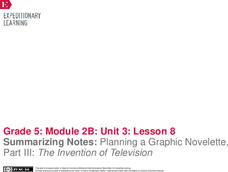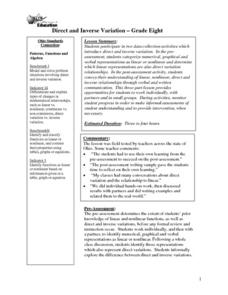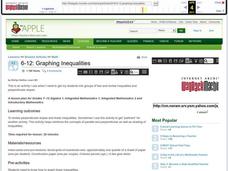EngageNY
Performance Task Preparation: Peer Critique and Mini-Lesson Addressing Common Errors: Revising Draft Essay to Inform
Time to revise! Using a writing evaluation rubric, scholars participate in a peer editing process to provide feedback on each others' informative essays. Next, pupils begin revising their drafts based on the feedback they receive.
EngageNY
Summarizing Notes: Planning a Graphic Novelette, Part III: The Invention of Television
How did the television change people's lives? Learners consider the question as they complete their storyboards about the invention of the TV, adding visual elements along the way. Then, they participate in a peer review to offer and...
National Endowment for the Humanities
The New Order for "Greater East Asia"
Sometimes the New Order becomes synonymous with its implications for European countries, but what about its consequences for East Asia? The final instructional activity in a four-part series teaches scholars about World War II. High...
West Contra Costa Unified School District
Divisibility Rules Justified
How do you know if a number is divisible? Instructors first prove the divisibility rules for three and four and then class members use this modeling to prove given divisibility rules for eight and nine either individually or in...
Cornell University
Mechanical Properties of Gummy Worms
Learners won't have to squirm when asked the facts after completing an intriguing lab investigation! Hook young scholars on science by challenging them to verify Hooke's Law using a gummy worm. Measuring the length of the worm as they...
US Institute of Peace
Responding to Conflict: Negotiation—Identifying Wants and Needs
Let's make a deal! Are real negotiations as simple as they are in the game show? Scholars learn the art of negotiation during the 8th lesson in a series of 15. The activity kicks off with a fun group negotiation, then explores the topic...
Weebly
Author Study: Eric Carle
Dive into an author study of one of the most beloved children’s book authors, Eric Carle. After reading some of his stories, including Papa Get me the Moon, A House for Hermit Crab, The Grouchy Ladybug, and The Very Busy...
Curated OER
Through the Looking Glass: Life in Colonial Times
Fourth graders examine the life and times of those living in the colonial era. With a partner, they use laptops to complete their research on different aspects of colonial life. They also role-play the role of colonists and share their...
Smithsonian Institution
Lexington and Concord: Historical Interpretation
Learners view and analyze three different images related to the Battle of Lexington and Concord. They also answer a variety of questions in a graphic organizer to help keep the information straight.
Curated OER
Partner Mile Run: Heart Rate Calculation
Students improve fitness, calculate target heart rates and prepare for the mile run physical fitness test.
Curated OER
Basketball Assessment: Left Handed Layup
Learners identify if their peers are using the correct cues when shooting a layup.
Curated OER
Charlie and the Chocolate Factory
Fourth graders research and write an author report on Roald Dahl, including books written by him, birthplace, family life, and other information on his writing. Students read aloud chapters in the book. Students create a newspaper...
Curated OER
Throwing and Catching Medley
Learners practice their throwing and catching skills while reinforcing cues learned previously in class. They throw and catch with a partner to music. They use at least six or seven different objects to hone their skills.
Curated OER
Scooter Pathways
Students travel different pathways on scooters - with a partner. The partner is evaluating whether or not the person on the scooter is moving in the correct pathway.
Curated OER
Forehand Clear Shot
Students practice their badminton skills while trying to achieve the three levels of performance designated by the teacher. Students work with partners and assess each other using the leveled sheets.
Curated OER
Measuring Fun
First graders practice measuring. In this measuring lesson, 1st graders read the story How Big Is a Foot? by Rolf Myller. They measure a partner using standard (ruler) and nonstandard (feet) units.
Curated OER
Direct and Inverse Variation
Eighth graders participate in two data collection activities that involve direct and inverse variation. In the pre-assessment, 8th graders categorize numerical, graphical, and verbal representations as linear or nonlinear and determine...
Curated OER
Poetry III--Haiku Writing
Students create and solve haiku riddles. In this haiku writing lesson plan, students work in groups to match a haiku to an illustration. Students write haiku and assess themselves and their peers.
Curated OER
Graphing Inequalities
Students graph linear equations and then find the person in class whose linear equation graph is perpendicular to theirs. In this graphing inequalities lesson plan, students graph their perpendicular slopes and then once their find their...
Curated OER
Shadow Matching
Students pair up with a partner and find a good self space. They choose who "match" who first (i.e., be the "leader"). Standing next to their partner, and only looking at their shadow, each student tries to match their partner
Curated OER
Spook Walk
Students work together with a partner in which they blindfold. With their partner, they must communicate directions to them that allows them to make it across the spook walk. To end the lesson, they discuss the communication skills they...
Curated OER
Reading and Poetry Theatre
Student increase their reading fluency through the use of various strategies. After reviewing crosschecking and cover-up, students complete an initial read of a novel text. Working with a partner, they read complete a timed assessment of...
Curated OER
Narrative Prompt
Second graders are introduced to the style of a narrative writing. After being read a story, they use a graphic organizer to plan their writing. With a partner, they share their ideas and decide on one topic to write about. To end the...
Curated OER
Carbon Usage and Offsets on Putnam City Campuses and Area Businesses
High schoolers examine carbon output. In this climate change lesson, students plan and complete an assessment of local businesses and schools based on the carbon output of their electrical usage.























